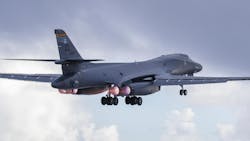L3Harris to repair and upgrade electronic warfare (EW) avionics subsystems aboard Air Force B-1 bomber
ROBINS AIR FORCE BASE, Ga. – Airborne electronic warfare (EW) experts at L3Harris Technologies Inc. will provide replaceable components for the U.S. Air Force AN/ALQ-161A defensive avionics on the B-1B jet bomber under terms of a $70 million contract announced Monday.
Officials of the U.S. Air Force Sustainment Center at Robins Air Force Base, Ga., are asking the L3Harris Space & Airborne Systems segment in Clifton, N.J., to repair and upgrade 154 AN/ALQ-161A RF, surveillance, and electronic countermeasures system line replaceable units (LRUs) and shop replaceable units (SRUs).
The AN/ALQ-161A helps B-1 bomber crews identify, acquire, and defend against enemy radar and missile systems. Built by L3Harris legacy company AIL Systems Inc., the AN/ALQ-161A is a totally integrated RF countermeasures system.
An LRU is a modular component designed for quick replacement, and can be stocked and replaced quickly. An SRU, meanwhile, is similar to an LRU, but represents component functions, such as circuit card assemblies, instead of being a complete functional units.
The AN/ALQ-161A avionics provides 360-degree receive and jamming coverage against many simultaneous threats, and also provides a tail warning function (TWF) to detect incoming missiles from behind the aircraft.
The AN/ALQ-161A is made up of more than 108 LRUs that weigh more than 5,000 pounds, consuming about 120 kilowatts of power.
The EW system on the aircraft sorts threats by priority and react against them automatically. The system also knows when it is dangerous to use RF jamming. When the system is on, it does not emit signals that would give away the B-1's position until they are needed.
When the jammer is on, it emits only in a certain direction. Moreover, when it emits jamming signals that could reveal its position, it does so only for a short time and then shuts down.
The AN/ALQ-161A, which first was delivered in the 1980s, has been sustained through upgrades and modifications to detect and counter an ever changing EW threat.
On this contract L3Harris will do the work in Amityville, N.Y., and should be finished by June 2025. For more information contact L3Harris Space and Airborne Systems online at www.l3harris.com, or the Air Force Sustainment Center at www.afsc.af.mil.
